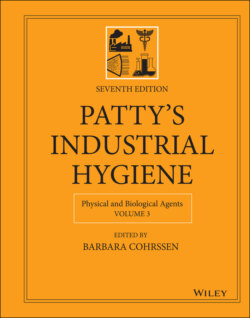Читать книгу Patty's Industrial Hygiene, Physical and Biological Agents - Группа авторов - Страница 27
4.2.1 Interaction with Matter
ОглавлениеThe physical mechanisms by which charged particles, such as alpha and beta particles, transfer their kinetic energy to matter are relatively well understood. The most likely occurrence is a collision between the charged particle and one of the extranuclear orbital electrons in the energy‐absorbing matter with which the radiation interacts. When the orbital electron is struck with sufficient force, it is knocked out of the atom, and the atom is said to be ionized. Ionization is the process of separating an electron from an atom, thereby upsetting the electrical neutrality of the atom and producing a pair of electrically charged particles – the ejected electron, which is the negative ion, and the residual atom, which is a positive ion. Work must be done by the ionizing particle, the alpha or beta particle, to separate the electron from its atom. An alpha particle loses an average of about 35.5 eV of energy per ion pair produced in air or in soft tissue, while a beta particle loses an average of about 34 eV per ionizing collision. These “collisions” are in reality interactions between the electric fields associated with the ionizing particles and the electrons in the absorbing media. Because an alpha particle has a large mass, moves slowly, and is doubly charged, it has a high rate of ionizing collisions, and consequently a high rate of energy loss. This high rate of energy loss explains the very low penetration of alpha radiation into matter. The linear rate of ion production is called the specific ionization. In air, the specific ionization of alpha particles is of the order of 104–105 ion pairs per centimeter 5.
Beta particles have only a single charge and travel at speeds near that of light. As a consequence, the specific ionization of beta particles is relatively low. While an alpha particle produces of the order of 50 000 ion pairs per centimeter in air, a beta particle in air produces only about 100 ion pairs per centimeter. This difference in the specific ionization between the two types of radiation is important in health physics for several reasons. First, it accounts for the higher penetrating power of beta particles than that of alpha radiation. For example, a 1.71‐MeV beta penetrates tissue to a depth of about 8 mm, while a 5.3‐MeV alpha, which has three times the energy, penetrates only about 0.005 cm of tissue. Second, it is utilized in the design of radiation‐measuring instruments sensitive to this difference in order to be able to distinguish between the two types of radiation.
